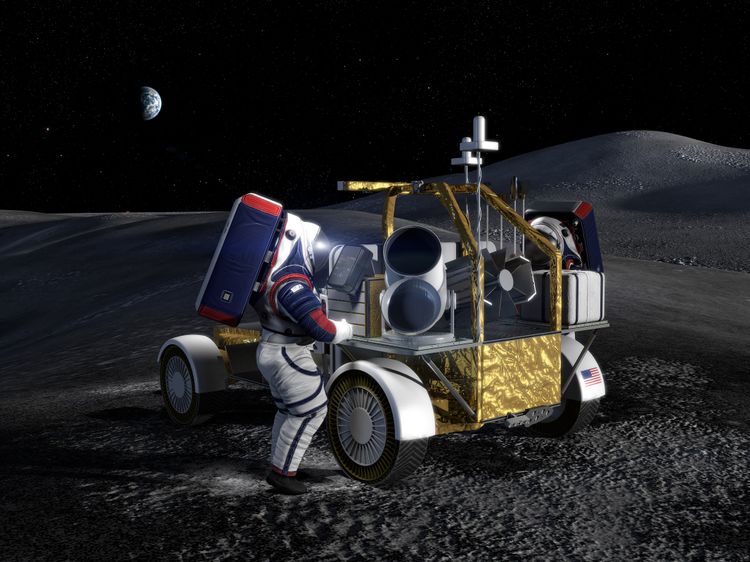
NASA will have some options when it decides to select its next moon buggy.
Aerospace giant Northrop Grumman announced on Tuesday (Nov. 16) that it's leading a private team designing a crewed Lunar Terrain Vehicle (LTV) for potential use by NASA's Artemis program, which aims to establish a sustainable human presence on and around the moon by the end of the 2020s.
"Together with our teammates, we will provide NASA with an agile and affordable vehicle design to greatly enhance human and robotic exploration of the lunar surface to further enable a sustainable human presence on the moon and, ultimately, Mars," Steve Krein, vice president of civil and commercial space in Northrop Grumman's tactical space systems division, said in a statement.
Those teammates are AVL, which develops, simulates and tests powertrains and other vehicle systems; tiremaker Michelin; Lunar Outpost, which is developing robotic rovers and other lunar-exploration tech; and Intuitive Machines, whose Nova-D lander would deliver the LTV to the lunar service.
Related: Driving on the Moon: Photos of NASA's Lunar Cars
Northrop Grumman and its partners are responding to a call from NASA, which last year asked the space industry for ideas about developing a crewed, unpressurized LTV for use near the moon's south pole. The agency plans to build an "Artemis Base Camp" in this region, which is thought to harbor lots of water ice.
In late August of this year, NASA asked for additional advice about the electric LTV, which will need to operate for at least 10 years on the lunar surface.
Get the Space.com Newsletter
Breaking space news, the latest updates on rocket launches, skywatching events and more!
"Most people do a lot of research before buying a car," Nathan Howard, project manager for the LTV at NASA's Johnson Space Center in Houston, said in an Aug. 31 statement. "We're doing extensive research for a modern space vehicle that will be provided by industry. As we plan for long-term exploration of the moon, the LTV won't be your grandfather's moon buggy used during the Apollo missions."
It's unclear at the moment if NASA will buy the LTV outright or if its developers will provide its use as a commercial service. That's one of the details the agency is trying to iron out in this information-gathering stage.
The Northrop Grumman-led team isn't the only private outfit developing an Artemis LTV. In May, Lockheed Martin and GM announced that they're teaming up on a crewed moon buggy of their own. At the time, a Lockheed executive said the two companies had been working on the vehicle "for a good portion of a year now."
Infographic: Living on the moon: What it would be like
The LTV is an unpressurized rover, meaning astronauts would have to keep their spacesuits on while driving it. But NASA also aims to provide Artemis astronauts with a big pressurized rover that they can live in for extended periods if need be.
NASA officials have said they plan to develop the pressurized moon rover in partnership with the Japan Aerospace Exploration Agency, which is building just such a vehicle with Toyota.
Northrop Grumman has a deep and long-standing relationship with NASA. For example, the company is the prime contractor on the agency's $10 billion James Webb Space Telescope, the highly anticipated observatory scheduled to launch on Dec. 18. Northrop Grumman also builds the robotic Cygnus spacecraft, which has been flying cargo missions to the International Space Station for NASA since 2013.
Northrop Grumman was also part of a team — along with Jeff Bezos' Blue Origin, Lockheed Martin and Draper — that vied for a contract to provide the Artemis program's initial Human Landing System. The agency ultimately awarded that contract to SpaceX, however.
Mike Wall is the author of "Out There" (Grand Central Publishing, 2018; illustrated by Karl Tate), a book about the search for alien life. Follow him on Twitter @michaeldwall. Follow us on Twitter @Spacedotcom or on Facebook.
Join our Space Forums to keep talking space on the latest missions, night sky and more! And if you have a news tip, correction or comment, let us know at: community@space.com.

Michael Wall is a Senior Space Writer with Space.com and joined the team in 2010. He primarily covers exoplanets, spaceflight and military space, but has been known to dabble in the space art beat. His book about the search for alien life, "Out There," was published on Nov. 13, 2018. Before becoming a science writer, Michael worked as a herpetologist and wildlife biologist. He has a Ph.D. in evolutionary biology from the University of Sydney, Australia, a bachelor's degree from the University of Arizona, and a graduate certificate in science writing from the University of California, Santa Cruz. To find out what his latest project is, you can follow Michael on Twitter.









